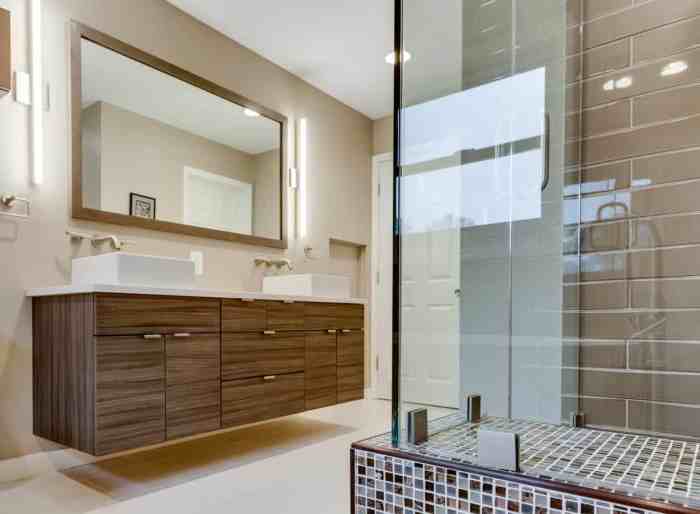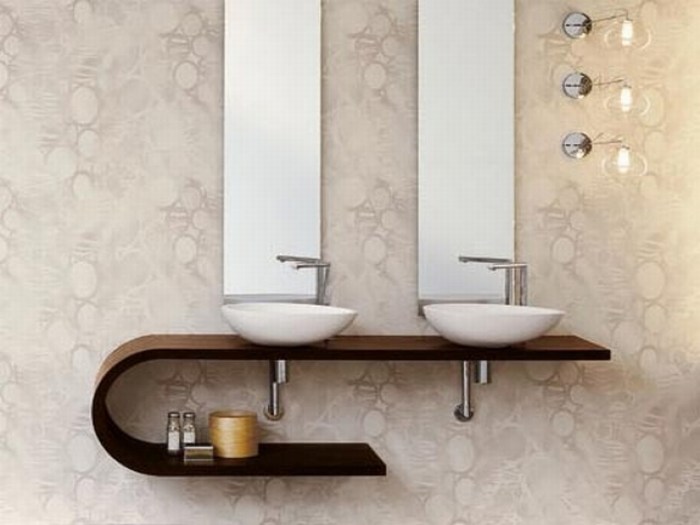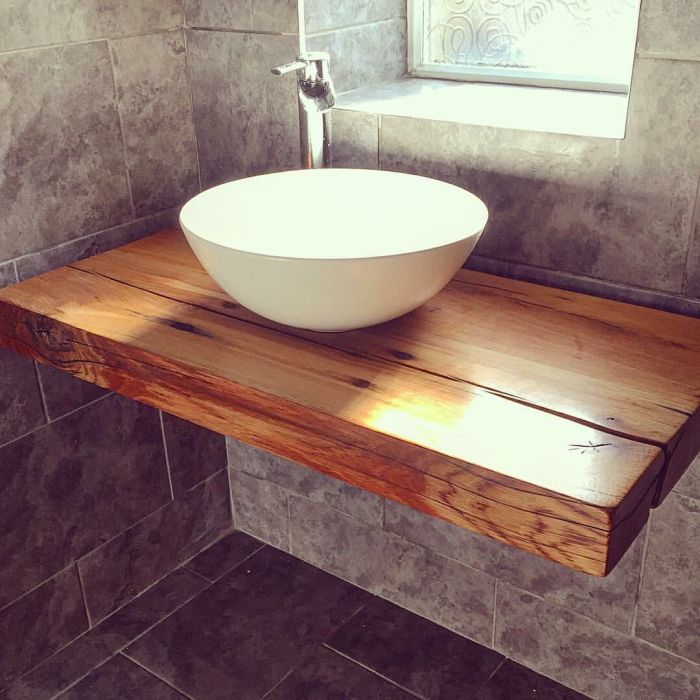In the realm of bathroom design, minimalism has emerged as a sought-after aesthetic, offering a blend of simplicity, functionality, and sophistication. Floating bathroom sinks, in particular, embody this minimalist philosophy, creating an illusion of spaciousness and tranquility while adding a touch of contemporary elegance to your bathroom.
This guide will delve into the world of minimalist floating bathroom sink designs, exploring their key principles, diverse styles, material considerations, functional features, and installation techniques. We will also provide inspiring design inspiration and answer frequently asked questions to help you make informed decisions and create a bathroom that exudes both style and functionality.
Minimalist Design Principles
Minimalist design emphasizes simplicity, functionality, and clean lines. Applied to bathroom sinks, these principles translate into sleek, uncluttered designs that prioritize space and tranquility.
Minimalist bathroom sinks create a sense of spaciousness, as they eliminate unnecessary clutter and ornamentation. They promote a calming and serene atmosphere, as their simple forms and neutral colors reduce visual noise and promote relaxation.
Key Features
- Clean, geometric lines
- Neutral colors (white, black, gray)
- Concealed storage for toiletries
- Minimal hardware
Floating Sink Styles
Floating bathroom sinks, characterized by their lack of visible support, offer a sleek and contemporary aesthetic to any bathroom. These sinks come in a variety of styles, each with its own unique advantages and applications.
The most common type of floating sink is the wall-mounted sink, which is directly attached to the wall with concealed brackets. Wall-mounted sinks are a great space-saving option, as they do not require any additional cabinetry or countertops. They also create a clean and minimalist look, as the sink appears to be floating in mid-air.
Console sinks are another popular type of floating sink. These sinks are typically supported by a single or two legs, which are attached to the floor. Console sinks offer a bit more storage space than wall-mounted sinks, as they often have a shelf or drawer underneath the sink.
They are also a good option for smaller bathrooms, as they do not take up as much space as a traditional vanity.
Pedestal sinks are a classic type of floating sink that has been around for centuries. These sinks are supported by a single pedestal, which is attached to the floor. Pedestal sinks are a good option for traditional or vintage-style bathrooms, as they add a touch of elegance and sophistication.
Wall-Mounted Sinks
- Mounted directly to the wall with concealed brackets
- Space-saving and minimalist
- Available in a variety of shapes and sizes
Console Sinks
- Supported by one or two legs attached to the floor
- Offer more storage space than wall-mounted sinks
- Good option for smaller bathrooms
Pedestal Sinks
- Supported by a single pedestal attached to the floor
- Classic and elegant design
- Good option for traditional or vintage-style bathrooms
Material Considerations
The choice of material for a minimalist floating bathroom sink significantly impacts its durability, aesthetics, and cost. Let’s explore the advantages and disadvantages of the most common materials used:
Ceramic
Ceramic sinks are renowned for their durability and ease of cleaning. They are resistant to stains, scratches, and heat, making them suitable for high-traffic bathrooms. However, ceramic sinks can be heavy and may require additional support for proper installation.
Stone
Natural stone sinks, such as marble or granite, exude elegance and sophistication. They are durable and heat-resistant, providing a luxurious touch to any bathroom. However, stone sinks can be porous and require regular sealing to prevent staining.
Glass
Glass sinks offer a modern and airy aesthetic. They are non-porous, making them hygienic and easy to clean. However, glass sinks are more fragile than other materials and may be prone to chips or cracks if not handled with care.
Metal
Metal sinks, typically made of stainless steel or copper, provide a sleek and industrial look. They are durable, corrosion-resistant, and relatively easy to maintain. However, metal sinks can be noisy and may require special cleaning products to prevent tarnishing.
Functional Features
When selecting a minimalist floating bathroom sink, it’s essential to consider its functional features to ensure both practicality and aesthetic appeal.
These features include basin size, drainage type, and faucet compatibility. Each element plays a crucial role in determining the sink’s overall functionality and how it complements the bathroom’s design.
Basin Size
The basin size is a critical factor to consider as it affects the sink’s usability and storage capacity. Smaller basins are suitable for compact bathrooms or powder rooms, while larger basins offer more space for washing and rinsing.
Drainage Type
The drainage type refers to the mechanism used to drain water from the sink. Common options include pop-up drains and slotted drains. Pop-up drains are discreet and easy to operate, while slotted drains provide a larger drainage area and prevent clogging.
Faucet Compatibility
Faucet compatibility ensures that the sink and faucet work seamlessly together. Different sink designs may require specific faucet types, such as wall-mounted or deck-mounted faucets. It’s essential to verify compatibility before purchasing to avoid any installation issues.
Installation Considerations
Installing a floating bathroom sink requires careful planning and precise execution. Here are the steps to guide you through the process:
Before beginning, ensure you have the necessary tools and materials, including a drill, screwdriver, level, measuring tape, mounting brackets, screws, and plumbing supplies.
Mounting Methods
- Wall-Mounted: The sink is secured directly to the wall using mounting brackets. This method requires precise drilling and anchoring into the wall studs for stability.
- Countertop-Mounted: The sink is installed on top of a countertop, which is then secured to the wall. This method offers more flexibility in placement but may require additional support depending on the countertop material.
Plumbing Connections
Once the sink is mounted, connect the plumbing. Use flexible water supply lines and a P-trap to connect the sink to the water supply and drain.
Ensure all connections are secure and watertight by applying plumber’s tape or using compression fittings. Test the plumbing for leaks before using the sink.
Maintenance and Care
Maintaining a minimalist floating bathroom sink is essential to ensure its longevity and aesthetic appeal. Regular cleaning and proper care can prevent stains, damage, and ensure optimal functionality.
Daily cleaning involves wiping down the sink surface with a damp cloth and mild soap. Avoid using harsh chemicals or abrasive cleaners, as they can damage the finish. For deeper cleaning, use a non-abrasive cleaner specifically designed for bathroom fixtures.
Rinse thoroughly with clean water to remove any residue.
Preventing Stains
To prevent stains, it’s crucial to address spills and splashes promptly. Use a damp cloth to wipe away any liquids or residue immediately. Hard water deposits can be removed using a vinegar solution or commercial descaling products.
Addressing Potential Issues
In case of any leaks or clogs, it’s important to address them promptly. Leaks can damage the surrounding area, while clogs can affect water flow and hygiene. Contact a qualified plumber for professional assistance in resolving these issues.
By following these maintenance and care tips, you can ensure that your minimalist floating bathroom sink remains in pristine condition for years to come.
Design Inspiration
Minimalist floating bathroom sink designs draw inspiration from various sources, showcasing their versatility and adaptability to different bathroom styles. These designs are characterized by their clean lines, geometric shapes, and use of natural materials.
Incorporating floating sinks into minimalist bathrooms can enhance the sense of space and create a serene ambiance. The absence of bulky cabinetry underneath the sink allows for more floor space, making the bathroom feel larger and more airy.
Contemporary Style
Contemporary minimalist floating bathroom sink designs often feature sleek lines and angular shapes. They may be made of materials such as white porcelain, black granite, or brushed nickel. These sinks complement modern bathroom fixtures and accessories, creating a cohesive and sophisticated look.
Traditional Style
Floating sinks can also be incorporated into traditional bathroom styles. Opt for sinks with curved edges or ornate detailing to complement the classic features of a traditional bathroom. Materials like marble or cast iron can add a touch of elegance and sophistication to the space.
Industrial Style
For industrial-style bathrooms, floating sinks made of concrete, metal, or reclaimed wood can create a raw and edgy aesthetic. These sinks often feature exposed plumbing and fixtures, adding to the industrial charm of the bathroom.
Coastal Style
In coastal-style bathrooms, floating sinks made of natural materials like stone or wood can evoke a sense of serenity and connection to nature. They may feature organic shapes or be adorned with seashells or other coastal elements.
Outcome Summary
Embracing minimalist floating bathroom sink designs is a journey towards creating a serene and modern bathroom space. By understanding the principles of minimalism, exploring the various styles and materials available, and considering functional features and installation techniques, you can transform your bathroom into a sanctuary of tranquility and sophistication.
Remember, a minimalist approach is not about deprivation but rather about creating a space that is both aesthetically pleasing and highly functional. With careful planning and attention to detail, you can achieve a minimalist floating bathroom sink design that will elevate your daily routine and enhance the overall ambiance of your home.



